Super Xevious
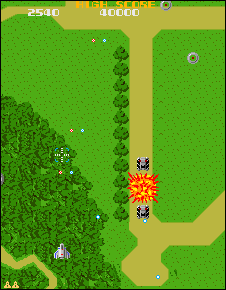 The Game: As the commander of a sleek Solvalou fighter, you’re deep into enemy territory, shooting their disc-shaped fighters out of the sky, bombing ground installations and artillery nests, bombing tanks, and trying to destroy the mothership. As you progress further behind enemy lines, heavier aircraft and more versatile and Buy this gamedeadly ground-based defenses become the norm. Also look out for tumbling airborne mirrors – they’re impervious to your fire, but you’re toast if you fly right into them. (Atari [under license from Namco], 1984)
The Game: As the commander of a sleek Solvalou fighter, you’re deep into enemy territory, shooting their disc-shaped fighters out of the sky, bombing ground installations and artillery nests, bombing tanks, and trying to destroy the mothership. As you progress further behind enemy lines, heavier aircraft and more versatile and Buy this gamedeadly ground-based defenses become the norm. Also look out for tumbling airborne mirrors – they’re impervious to your fire, but you’re toast if you fly right into them. (Atari [under license from Namco], 1984)
Memories: The original arcade Xevious was no pushover, but like several of its Namco stablemates, it was possible to outwit the machine by using some of its own pattern-based programming against it. With Super Xevious, this was more difficult, because the game’s internal A.I. was adaptive and could throw more at the player based on his demonstrated skill level. But some players had discovered a solution to this adaptive enemy intelligence, and games lasting more than ten minutes on a single quarter were not uncommon.
Space Ace

 The Game: You’re intergalactic hero Space Ace one moment, but the next moment, the evil Borf kidnaps your girlfriend Kimberly and unleashes the Infanto-Ray on you…and suddenly, you’re intergalactic geek Dexter. Borf has placed an enormous number of deadly obstacles between you and him, obstacles which Space Ace could vanquish in no time flat – but you can only turn into the bemuscled one for brief periods of time… (Starcom, 1984)
The Game: You’re intergalactic hero Space Ace one moment, but the next moment, the evil Borf kidnaps your girlfriend Kimberly and unleashes the Infanto-Ray on you…and suddenly, you’re intergalactic geek Dexter. Borf has placed an enormous number of deadly obstacles between you and him, obstacles which Space Ace could vanquish in no time flat – but you can only turn into the bemuscled one for brief periods of time… (Starcom, 1984)
Memories: Another laserdisc game from the Don Bluth/Rick Dyer team that brought you Dragon’s Lair, Space Ace makes some minor improvements on its predecessor, while still falling victim to many of the same basic problems.
Snake Pit
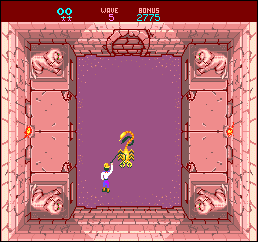 The Game: You’re an adventurer with a bullwhip and a hat, and you hate snakes and love treasure – sound familiar? The bad news is that you’re surrounded by slippery snakes, scurrying scorpions and jumping spiders, all of whom can kill you instantly on contact. The only way you can eliminate these foes and claim the treasure is with a precisely-aimed crack of your whip…but if you’re surrounded, your treasure-hunting days are probably over. (Bally Sente, 1984)
The Game: You’re an adventurer with a bullwhip and a hat, and you hate snakes and love treasure – sound familiar? The bad news is that you’re surrounded by slippery snakes, scurrying scorpions and jumping spiders, all of whom can kill you instantly on contact. The only way you can eliminate these foes and claim the treasure is with a precisely-aimed crack of your whip…but if you’re surrounded, your treasure-hunting days are probably over. (Bally Sente, 1984)
Memories: When Warner Bros. bought Atari, it quickly became apparent that Atari founder Nolan Bushnell and new CEO Ray Kassar – Warner’s newly installed point man at Atari – were an uneasy fit at best. Though accounts differ between the two men, the final straw seems to have been Bushnell calling an executive board meeting and not quite getting around to inviting Kassar to it, after which Kassar went to his Warner Bros. boss, Manny Gerard, and drew up the legal papers to forcibly retire Bushnell from his duties at Atari. Bushnell was put – as Atari senior staffers called it – “on the beach,” with no say in the company’s future but a healthy percentage of a bonus pool that depended on the company’s performance.
Return Of The Jedi
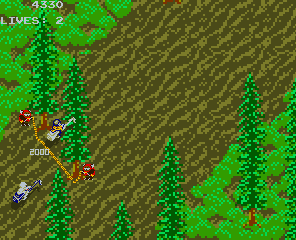
 The Game: In the first screen, you’re zipping through the forest of Endor on a stolen speeder bike, with Imperial stormtroopers on their own bikes chasing you. While you can shoot the stormtroopers’ bikes or bump them off the playing field, they can shoot you, and running into trees isn’t good for anyone’s health. Your only advantage? The indigenous Ewoks, those furry little critters who occupy a special, beloved place in every Star Wars fan’s heart, will help you out if you lead the stormtroopers into their primitive traps. The second screen is much like the first, only you’re flying the Millennium Falcon through the Death Star trenches, and the other speeder bikes are now TIE Interceptors. (Atari, 1984)
The Game: In the first screen, you’re zipping through the forest of Endor on a stolen speeder bike, with Imperial stormtroopers on their own bikes chasing you. While you can shoot the stormtroopers’ bikes or bump them off the playing field, they can shoot you, and running into trees isn’t good for anyone’s health. Your only advantage? The indigenous Ewoks, those furry little critters who occupy a special, beloved place in every Star Wars fan’s heart, will help you out if you lead the stormtroopers into their primitive traps. The second screen is much like the first, only you’re flying the Millennium Falcon through the Death Star trenches, and the other speeder bikes are now TIE Interceptors. (Atari, 1984)
The Game: Though graphically superior, and almost certainly guaranteed to gross more quarters just because of the Star Wars association, this game was, more or less, Zaxxon with a new paint job. Still, many players at the time hailed it as a vast step up from the vector graphics Star Wars game which Atari had released the previous year, even if the controls were aggravating.
Pirate Ship Higemaru
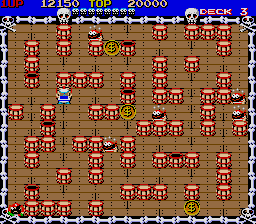 The Game: Pirates have boarded your ship, and it’s up to you to defend the whole boat. Evade the pirates in the twisty mazes of barrels and treasures in the cargo deck, or pick up one of those barrels and brain the nearest pirate with it. Be careful – some pirates hide inside the barrels, and it’s instant death to pick up an “occupied” barrel and not back off quickly. Some containers reveal a treasure when you pick them up, and you can go back and grab the treasures for bonus points. Clear the deck of pirates to advance to the next level and start again. (Capcom, 1984)
The Game: Pirates have boarded your ship, and it’s up to you to defend the whole boat. Evade the pirates in the twisty mazes of barrels and treasures in the cargo deck, or pick up one of those barrels and brain the nearest pirate with it. Be careful – some pirates hide inside the barrels, and it’s instant death to pick up an “occupied” barrel and not back off quickly. Some containers reveal a treasure when you pick them up, and you can go back and grab the treasures for bonus points. Clear the deck of pirates to advance to the next level and start again. (Capcom, 1984)
Memories: Not released in the United States, Pirate Ship Higemaru is a nice little riff on the basic concept of Pengo. You can move the components of the “maze”around as you wish, or use those same components to dispose of enemies. Since the procedure for doing this in Higemaru is a bit more complicated than Pengo, there’s actually a training round that must be completed before the game truly begins – but it’s not risk-free, and you can actually lose a life in training! (I guess the message is that if you can’t get past the training screen, please let someone else put a coin in the machine and defend the boat.)
Pac-Land
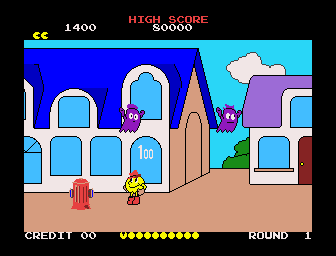 The Game: In a total break with any and all previous Pac-Man games, Pac-Land puts the yellow one onscreen as a very good homage to the Hanna-Barbera Saturday morning cartoon based on the original game, complete with the show’s bubbly theme song. You wander down the streets of Pac-Land, avoiding those nasty Ghost Monsters and hoping to find Power Pellets, all before your time runs out for that phase of your journey. Ghost Monsters may attack from the ground, or try to bomb you from the air; either way, chomping a Power Pellet will relieve them of their altitude and put them on the run. You may have to jump over them or duck under them until then – and be very careful in the forest, where Ghost Monsters may lurk behind trees. (Bally/Midway [under license from Namco], 1984)
The Game: In a total break with any and all previous Pac-Man games, Pac-Land puts the yellow one onscreen as a very good homage to the Hanna-Barbera Saturday morning cartoon based on the original game, complete with the show’s bubbly theme song. You wander down the streets of Pac-Land, avoiding those nasty Ghost Monsters and hoping to find Power Pellets, all before your time runs out for that phase of your journey. Ghost Monsters may attack from the ground, or try to bomb you from the air; either way, chomping a Power Pellet will relieve them of their altitude and put them on the run. You may have to jump over them or duck under them until then – and be very careful in the forest, where Ghost Monsters may lurk behind trees. (Bally/Midway [under license from Namco], 1984)
 Memories: It may have been well-drawn and animated, but Pac-Land really stuck out like a sore thumb to me – in hindsight, it was more like Super Mario Bros. than Pac-Man. Still, for those few of us who initially liked the Saturday morning cartoon, this game was a lovingly crafted valentine to the TV version of Pac-Man – a very roundabout example of a video game inspired by a licensing spin-off inspired by a video game.
Memories: It may have been well-drawn and animated, but Pac-Land really stuck out like a sore thumb to me – in hindsight, it was more like Super Mario Bros. than Pac-Man. Still, for those few of us who initially liked the Saturday morning cartoon, this game was a lovingly crafted valentine to the TV version of Pac-Man – a very roundabout example of a video game inspired by a licensing spin-off inspired by a video game.
Mr. Do! Run Run
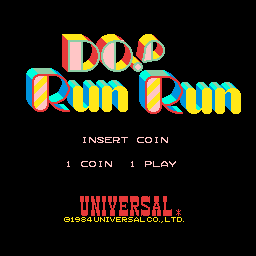 The Game: As everyone’s favorite pixellated clown since Bozo, you guide Mr. Do around a multi-level platform, pursued by multicolored killer critters. You have a magic power ball you can shoot at them, but if you score a hit, you’ll have to scramble around and pick up fruit and other items on the platforms until you have the strength to hurl another power ball. If, in the other hand, your power ball doesn’t score a direct hit, it will ricochet back and forth across the screen until you retrieve it, or it hits a monster that has wandered into that part of the screen. (You can only have one power ball bouncing around at a time.) (Universal, 1984)
The Game: As everyone’s favorite pixellated clown since Bozo, you guide Mr. Do around a multi-level platform, pursued by multicolored killer critters. You have a magic power ball you can shoot at them, but if you score a hit, you’ll have to scramble around and pick up fruit and other items on the platforms until you have the strength to hurl another power ball. If, in the other hand, your power ball doesn’t score a direct hit, it will ricochet back and forth across the screen until you retrieve it, or it hits a monster that has wandered into that part of the screen. (You can only have one power ball bouncing around at a time.) (Universal, 1984)
Memories: An odd cross between the game mechanics of Mr. Do! and the almost-but-not-quite-3-D graphics of Congo Bongo, Mr. Do! Run Run was actually quite a fun and frantic little game. It also sported some killer music for its time – very weird in places, almost Carl-Stalling-by-way-of-Devo, but still very enjoyable. The graphics are very clean, and the evil critters are actually cute. Considering the game’s “kill-’em-all” premise, it’s pretty cute for such a bloodthirsty exercise!
Mr. Do!’s Wild Ride
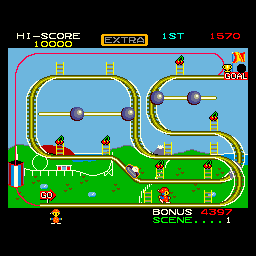 The Game: Mr. Do, having vanquished unicorns and other beasties, decides to take a little bit of vacation time at the nearest amusement park. But there’s one problem! (Isn’t there always?) The roller coasters are trying to kill him. Your job is to guide Mr. Do along the roller coaster tracks, avoiding deadly fast-moving roller coaster cars and climbing little ladders to reach cherries (is it my imagination, or does this guy eat more cherries than anybody since Pac-Man?). Watch your head at all times! (Universal, 1984)
The Game: Mr. Do, having vanquished unicorns and other beasties, decides to take a little bit of vacation time at the nearest amusement park. But there’s one problem! (Isn’t there always?) The roller coasters are trying to kill him. Your job is to guide Mr. Do along the roller coaster tracks, avoiding deadly fast-moving roller coaster cars and climbing little ladders to reach cherries (is it my imagination, or does this guy eat more cherries than anybody since Pac-Man?). Watch your head at all times! (Universal, 1984)
Memories: The fourth and final entry in the obscure attempt at a Mr. Do! franchise, this one is also my least favorite – but that’s not to say that it isn’t fun. First off, I just find the theme appealing. In Do Run Run!, one is required to kill off endless waves of killer kritters, making Mr. Do the blood-thirstiest clown since John Wayne Gacy. This game, however, takes a less violent approach – things can happen to you, sure, but they’re not the deliberate acts of sinister characters who are hell-bent on destroying you.
Millipede
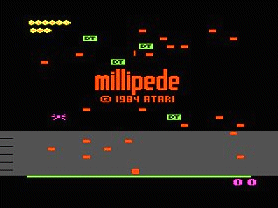
 The Game: Once more unto the breach, your garden of mushrooms is now under attack by a millipede, and the big bug’s even nastier insect entourage has come along too. The spiders, scorpions and fleas are now joined by mosquitoes and inchworms, among others. The only advantage you have? Occasional containers of DDT (can you tell this was the 80’s?) will allow you to wipe out all targets within a given radius…but use them wisely! (Atari, 1984)
The Game: Once more unto the breach, your garden of mushrooms is now under attack by a millipede, and the big bug’s even nastier insect entourage has come along too. The spiders, scorpions and fleas are now joined by mosquitoes and inchworms, among others. The only advantage you have? Occasional containers of DDT (can you tell this was the 80’s?) will allow you to wipe out all targets within a given radius…but use them wisely! (Atari, 1984)
Memories: Though the graphics aren’t markedly different from those of the Atari 2600 version of Centipede, the elements of the game are a great deal more challenging. In a way, Millipede isn’t quite so well-suited to the trakball controller…it’s just too fast.
Lode Runner
The Game: Cavernous rooms are loaded with gold, just ripe for the picking. But before you celebrate hitting the mother lode, look again – there are other gold-diggers homing in on the treasure. What do you have that they don’t? A drill gun that can blast a hole in the floors, into which your opponents will jump blindly. Eventually, the holes will reseal themselves, and that process will swallow your enemies (and you, if you happen to be clumsy enough to wander into the hole yourself). Grabbing all of the gold will reveal a passage to the next level of the game. (IREM [under license from Broderbund], 1984)
Memories: Lode Runner is right up there with the Ultima series and SimCity in my personal hall of fame of the coolest games ever to originate on any model of personal computer.
Grobda
 The Game: You’re piloting a lone tank trapped in an arena with numerous indestructible obstacles – and quite a few hostile tanks. The moment you’re sent into battle, those other tanks converge on you immediately, so survival usually
The Game: You’re piloting a lone tank trapped in an arena with numerous indestructible obstacles – and quite a few hostile tanks. The moment you’re sent into battle, those other tanks converge on you immediately, so survival usually  hinges on finding an advantageous configuration of obstacles to use as a makeshift fortress from behind which you can try to pick off enemy tanks without giving them a clear shot at yours. When you blast an enemy tank, it’s best not to be too close to it, because the shockwave of an exploding tank can catch nearby tanks and share the destruction, sometimes allowing you to fire one shot and set off a screen-clearing chain reaction. (Also, exploding tanks leave behind craters that slow you down if you try to cross over them.) You have a shielding system that offers very temporary shelter from enemy fire and from the explosions of nearby enemies, but constant firing and shield use will drain your precious energy reserves, and if that happens you’re as good as dead. (Namco, 1984)
hinges on finding an advantageous configuration of obstacles to use as a makeshift fortress from behind which you can try to pick off enemy tanks without giving them a clear shot at yours. When you blast an enemy tank, it’s best not to be too close to it, because the shockwave of an exploding tank can catch nearby tanks and share the destruction, sometimes allowing you to fire one shot and set off a screen-clearing chain reaction. (Also, exploding tanks leave behind craters that slow you down if you try to cross over them.) You have a shielding system that offers very temporary shelter from enemy fire and from the explosions of nearby enemies, but constant firing and shield use will drain your precious energy reserves, and if that happens you’re as good as dead. (Namco, 1984)
Memories: Not one of the most original games in Namco’s history, Grobda borrows game play concepts left and right from some of the all-time arcade greats, boils them into one stew, and speeds things up considerably.
Gaplus / Galaga 3
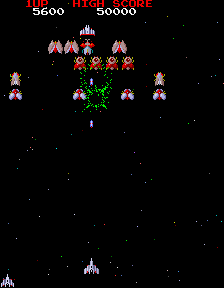 The Game: The Galaxian/Galaga saga continues! You control a solo space fighter against unending hordes of alien attackers who dive, weave, and evade your fire, while trying to nail your ship with their own shots. But one of
The Game: The Galaxian/Galaga saga continues! You control a solo space fighter against unending hordes of alien attackers who dive, weave, and evade your fire, while trying to nail your ship with their own shots. But one of  the aliens is hauling precious cargo: a device used to generate a tractor beam. In Galaga, the aliens used this weapon to capture and control your own fighters, using them against you. Now you can turn the tables by destroying the alien ferrying this precious piece of technology (but don’t shoot the device itself!). You’ll be able to capture an entire row of alien ships, using all of them to fire simultaneously at the next wave of attackers. If alien fire destroys one of your captured ships, the others, and your ship, survive; if they manage to draw a bead on your own fighter, however, all bets are off. (Namco, 1984)
the aliens is hauling precious cargo: a device used to generate a tractor beam. In Galaga, the aliens used this weapon to capture and control your own fighters, using them against you. Now you can turn the tables by destroying the alien ferrying this precious piece of technology (but don’t shoot the device itself!). You’ll be able to capture an entire row of alien ships, using all of them to fire simultaneously at the next wave of attackers. If alien fire destroys one of your captured ships, the others, and your ship, survive; if they manage to draw a bead on your own fighter, however, all bets are off. (Namco, 1984)
Memories: This sequel to Galaga was titled Gaplus in Japan (and in its limited original release in the U.S., if I’m not mistaken). In an attempt to draw more attention to it by tying it to a familiar property, Namco rechristened the sequel Galaga 3 for widespread American distribution. Whatever you call it (I tend to remember it as Gaplus myself), it’s a very difficult game.
Dragon’s Lair II: Timewarp
 The Game: Princess Daphne has been kidnapped by the evil wizard Mordroc, and before he can embark on the dangerous quest to save her, Dirk must first fend off the angry attack of his Viking-like mother-in-law as he makes
The Game: Princess Daphne has been kidnapped by the evil wizard Mordroc, and before he can embark on the dangerous quest to save her, Dirk must first fend off the angry attack of his Viking-like mother-in-law as he makes  his way to the castle. Once there, Dirk discovers a talking Time Machine which gets him out of one immediate crisis and then plunges him into several more. If Dirk can’t stop Mordroc from placing his ring on Daphne’s finger, he’ll lose her forever – and the world will have gained one more hideous monster. (Starcom, 1984)
his way to the castle. Once there, Dirk discovers a talking Time Machine which gets him out of one immediate crisis and then plunges him into several more. If Dirk can’t stop Mordroc from placing his ring on Daphne’s finger, he’ll lose her forever – and the world will have gained one more hideous monster. (Starcom, 1984)
Memories: Don Bluth and Rick Dyer turned to the adventures of Dirk the Daring (hero of the original Dragon’s Lair) for their third laserdisc game outing (the second being Space Ace), this time creating more of a storyline for Dirk to fulfill. The animation is nice, the game play is much more fast and furious, and yet I’m still unimpressed with Dragon’s Lair II as both video game and storytelling exercise.
Circus Charlie
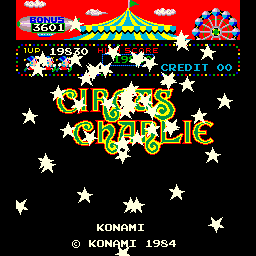
 The Game: As Charlie the circus clown, you undertake numerous hazardous activities to wow the big-top audience, including ridng a lion as he jumps through flaming hoops, walking a tightrope also inhabited by numerous monkeys over whom you must jump, leaping around on a series of trampolines (and hopefully over fire-breathers and knife-throwers who happen to be displaying their circus skills in an upward direction between trampolines), and finally a death-defying flying trapeze act. You only get three opportunities to strut your stuff, and then the show’s over. (Konami, 1984)
The Game: As Charlie the circus clown, you undertake numerous hazardous activities to wow the big-top audience, including ridng a lion as he jumps through flaming hoops, walking a tightrope also inhabited by numerous monkeys over whom you must jump, leaping around on a series of trampolines (and hopefully over fire-breathers and knife-throwers who happen to be displaying their circus skills in an upward direction between trampolines), and finally a death-defying flying trapeze act. You only get three opportunities to strut your stuff, and then the show’s over. (Konami, 1984)
It’s really like Track & Field with clown makeup, which in itself is somewhat disturbing. However you slice it, Circus Charlie is good clean fun, sort of the un-cola of sports games – there are a number of events (the game’s various “difficulty levels”), and the structure of the game is even the same, though here the action is confined to side-scrolling levels and it doesn’t feel like a sports game.
Buggy Challenge
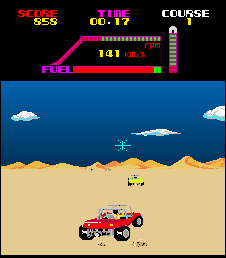 The Game: It’s a duel for dune buggy supremacy, and it won’t be easy. Drivers must contend not only with other drivers, but with dangerous terrain (sand hills that can launch a buggy into mid-air with little or no control over where it might land), killer obstacles including rocks and fence posts, and the amazing ease of losing all sense of direction. (Taito, 1984)
The Game: It’s a duel for dune buggy supremacy, and it won’t be easy. Drivers must contend not only with other drivers, but with dangerous terrain (sand hills that can launch a buggy into mid-air with little or no control over where it might land), killer obstacles including rocks and fence posts, and the amazing ease of losing all sense of direction. (Taito, 1984)
Memories: A fairly obscure first-person racer from Taito, Buggy Challenge is visually impressive, but in an era when it seemed like arcade game manufacturers were desperately trying to add complexity to control schemes – after all, a complex control scheme will probably get players “killed” more often, forcing more coin drop – Buggy Challenge most outstanding feature may be its blissful simplicity. There’s a gas pedal and a steering wheel. Try not to hit stuff that will cause the dune buggy to blow up. It really is that simple.
Xevious
 The Game: As the commander of a sleek Solvalou fighter, you’re deep into enemy territory, shooting their disc-shaped fighters out of the sky, bombing ground installations and artillery nests, bombing tanks, and trying to destroy the mothership. As you progress further behind enemy lines, heavier aircraft and more versatile and deadly ground-based defenses become the norm. Also look out for tumbling airborne mirrors – they’re impervious to your fire, but you’re toast if you fly right into them. (Atari, 1983)
The Game: As the commander of a sleek Solvalou fighter, you’re deep into enemy territory, shooting their disc-shaped fighters out of the sky, bombing ground installations and artillery nests, bombing tanks, and trying to destroy the mothership. As you progress further behind enemy lines, heavier aircraft and more versatile and deadly ground-based defenses become the norm. Also look out for tumbling airborne mirrors – they’re impervious to your fire, but you’re toast if you fly right into them. (Atari, 1983)
Memories: Based on a Namco import distributed under Atari’s banner in the U.S., Xevious may be about as close as one could get to replicating the arcade game with the 5200’s hardware. Curiously, though the copyright on the main menu screen is a year later than that on the unfinished 5200 Tempest proto, Xevious is a more complete game, fleshed out to a fully playable state.
UFO
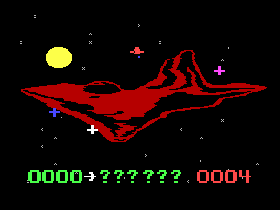 The Game: As the pilot of a lone space cruiser, you must try to clear the spaceways of a swarm of pesky and relatively harmless drone UFOs, but the job isn’t easy. You can ram the alien ships with your ship’s shields, destroying them (but forcing your shields offline for a few precious seconds during which anything could collide with your unprotected ship and destroy you), or shoot them (which also forces your shields down for a recharge). To that screenful of bite-sized chunks o’ death, add an unpredictable Killer UFO that likes to pop in and shoot at you, and suddenly being an interstellar traffic cop ain’t so easy. (Philips, 1983)
The Game: As the pilot of a lone space cruiser, you must try to clear the spaceways of a swarm of pesky and relatively harmless drone UFOs, but the job isn’t easy. You can ram the alien ships with your ship’s shields, destroying them (but forcing your shields offline for a few precious seconds during which anything could collide with your unprotected ship and destroy you), or shoot them (which also forces your shields down for a recharge). To that screenful of bite-sized chunks o’ death, add an unpredictable Killer UFO that likes to pop in and shoot at you, and suddenly being an interstellar traffic cop ain’t so easy. (Philips, 1983)
Memories: I’ve been complaining about the small library of Odyssey2-games-in-new-clothes developed as Odyssey3 launch titles quite a bit, but here’s a game I can actually get behind. UFO is the combination of a strong game in and of itself, with a background graphic that doesn’t completely obscure the in-game action.
Tutankham
 The Game: As an intrepid, pith-helmeted explorer, you’re exploring King Tut’s catacombs, which are populated by a variety of killer bugs, birds, and other nasties. You’re capable of firing left and right, but not vertically – so any oncoming threats from above or below must be outrun or avoided. Warp portals will instantly whisk you away to other parts of the maze (though this doesn’t necessarily mean safer). Gathering all of the treasures and keys will allow you to open the vault at the end of each level…which leads to the next, and even more difficult level. It’s like The Mummy, only much more entertaining. (Parker Brothers, 1983 – unreleased prototype)
The Game: As an intrepid, pith-helmeted explorer, you’re exploring King Tut’s catacombs, which are populated by a variety of killer bugs, birds, and other nasties. You’re capable of firing left and right, but not vertically – so any oncoming threats from above or below must be outrun or avoided. Warp portals will instantly whisk you away to other parts of the maze (though this doesn’t necessarily mean safer). Gathering all of the treasures and keys will allow you to open the vault at the end of each level…which leads to the next, and even more difficult level. It’s like The Mummy, only much more entertaining. (Parker Brothers, 1983 – unreleased prototype)
Memories: As far back as 1983, the year that it released four other titles for the Videopac (Europe’s equivalent to the Odyssey2), Parker Brothers had been mentioning other games in development for the system. The Videopac had a wider user base in Europe than the Odyssey2 had in North America, so the support was there. Spider-Man and Tutankham were announced as upcoming titles, and never surfaced as commercial releases. As it turns out, programming was relatively complete on both games, and the EPROM chips holding the work-in-progress versions of each game eventually fell in to the hands of collectors. Appropriately enough, Tutankham was an unearthed treasure.
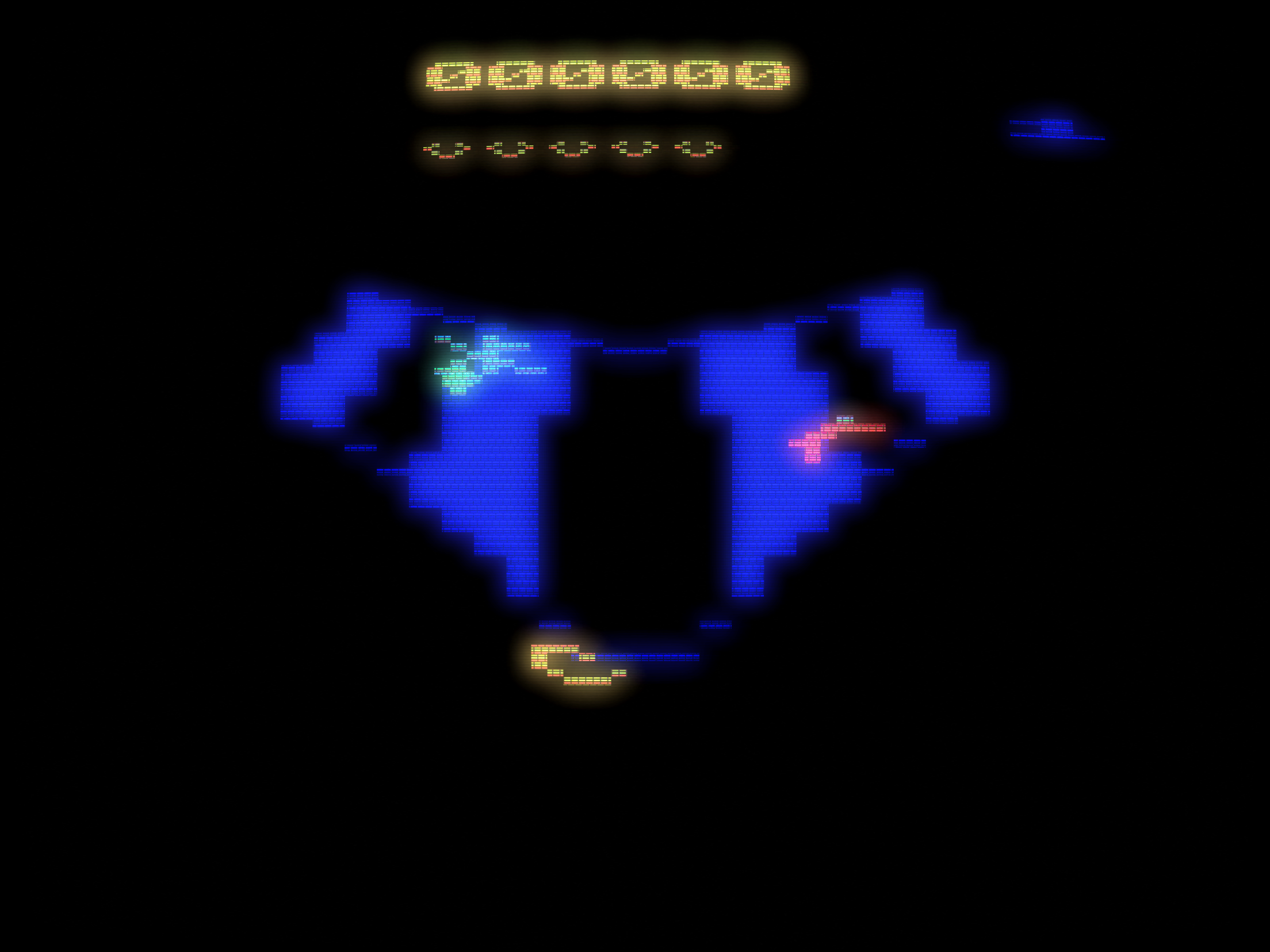
Tempest
 The Game: As a strangely crablike creature, you scuttle along the rim of an abstract, hollow geometric tube, zapping red bow-tie-ish critters and purple diamond-shaped things which carry them. There are also swirly green things (swirly thing alert!!) which spin “spikes” like webs, and by the way, you should avoid spikes. (Atari, 1983 – never released)
The Game: As a strangely crablike creature, you scuttle along the rim of an abstract, hollow geometric tube, zapping red bow-tie-ish critters and purple diamond-shaped things which carry them. There are also swirly green things (swirly thing alert!!) which spin “spikes” like webs, and by the way, you should avoid spikes. (Atari, 1983 – never released)
Memories: This version of Tempest never officially saw the light of day…but in looking at this attempt at a 2600 version of Atari’s own popular vector graphics game, one wonders if the game’s no-show wasn’t an attempt to prevent another turkey of Pac-proportions from marring Atari’s recently-repaired reputation.
Tempest
 The Game: As a strangely crablike creature, you scuttle along the rim of an abstract, hollow geometric tube, zapping red bow-tie-ish critters and purple diamond-shaped things which carry them. There are also swirly green things which spin “spikes” like webs, and by the way, you should avoid spikes. (Atari, 1983)
The Game: As a strangely crablike creature, you scuttle along the rim of an abstract, hollow geometric tube, zapping red bow-tie-ish critters and purple diamond-shaped things which carry them. There are also swirly green things which spin “spikes” like webs, and by the way, you should avoid spikes. (Atari, 1983)
Memories: The above description barely fits this game because it only exists in an unfinished form, with just a few bare essential elements of the game in place. You can shoot stuff and score points, but there isn’t much “game” there – the collision routines don’t exist that would determine whether or not your on-screen flipper “dies” by touching an approaching enemy, or an enemy’s incoming fire for that matter.
Spider-Man
 The Game: The Green Goblin and his henchmen are terrorizing the city once more, and it’s up to Spider-Man to restore order. But the odds are against him: he can only attach his web to the surface of the building, naturally, but the
The Game: The Green Goblin and his henchmen are terrorizing the city once more, and it’s up to Spider-Man to restore order. But the odds are against him: he can only attach his web to the surface of the building, naturally, but the  Goblin’s underlings are ready and eager to cut Spidey’s web should it be planted near them. Worse yet, the difficult-to-navigate high voltage tower at the top of the building is riddled with the Goblin’s bombs, and even if Spidey can defuse them, there’s a Super Bomb waiting for him at the top of the building – and he can only put it out of commission after dealing with the Green Goblin personally. (Parker Bros., 1983 / released by Bas Kornalijnslijper in 2006)
Goblin’s underlings are ready and eager to cut Spidey’s web should it be planted near them. Worse yet, the difficult-to-navigate high voltage tower at the top of the building is riddled with the Goblin’s bombs, and even if Spidey can defuse them, there’s a Super Bomb waiting for him at the top of the building – and he can only put it out of commission after dealing with the Green Goblin personally. (Parker Bros., 1983 / released by Bas Kornalijnslijper in 2006)
Memories: A chance discovery made by collector Bas Kornalijnslijper among a handful of ROM chips given to him by a former Phillips Electronics employee, Spider-Man was long known to have at least been in the works. Various advertising material touting the other four games created by Parker Bros. for the Videopac (the Odyssey2’s European near-twin) had mentioned that Spider-Man was “coming soon!” But of course, support for the Odyssey2 had largely disappeared by that time in North America (none of the Parker Bros. games were released there), and while it didn’t happen as quickly, the Videopac’s support also faded away in Europe; Spider-Man simply didn’t make it to market within that window. Now, along with another advertised-but-never-sold Parker Bros. title, Tutankham, Spider-Man has been unearthed.
Robot Rubble
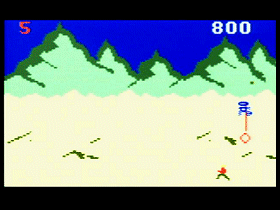 The Game: Robots descend from the mountains with one mission in mind: they’d like to fry you. In fact, they’re pretty adamant on that point. You’re armed with a weapon that can fling anti-robot grenades at them, but you have to account for a trajectory that can be affected by your own movement; mountainous outcroppings give you shelter, but not for long, since they also give the robots target practice. If you score a direct hit and blast a robot apart, you’re left with a narrow window of opportunity in which to land another grenade and permanently dismantle the remaining robot parts…if you can’t accomplish that, the robot will gather up its parts and reassemble itself to have another go at you. (Activision, 1983 – never released)
The Game: Robots descend from the mountains with one mission in mind: they’d like to fry you. In fact, they’re pretty adamant on that point. You’re armed with a weapon that can fling anti-robot grenades at them, but you have to account for a trajectory that can be affected by your own movement; mountainous outcroppings give you shelter, but not for long, since they also give the robots target practice. If you score a direct hit and blast a robot apart, you’re left with a narrow window of opportunity in which to land another grenade and permanently dismantle the remaining robot parts…if you can’t accomplish that, the robot will gather up its parts and reassemble itself to have another go at you. (Activision, 1983 – never released)
Memories: One of the strangest marketing policies to emerge from the golden age of video games was Activision‘s absurd – and eventually abandoned – strategy of trying to make its early Intellivision titles look and sound exactly like their Atari 2600 counterparts. While Activision was doing this, possibly to save the marketing department from having to prepare two different sets of artwork per game, Imagic vaulted ahead of them and became the definitive third-party software provider for the Intellivision. One only needs to look at the 2600 and Intellivision versions of Demon Attack or Atlantis to formulate the question “Why on Earth would Activision hobble their own developers like that?”
Robot City
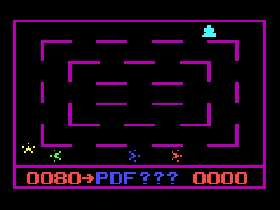 The Game: Four robotic tanks search methodically through a maze, trying to hunt you down. If you wind up in a straight line across or above/below the robot tanks, they will fire, even if a maze wall is in the way. Your job is to evade their fire, use the robots’ logic against them (i.e. try to get one tank to shoot another just because you’re in a straight line with them), or sneak up from behind and destroy them. Destroyed tanks leave a radioactive crater that you must avoid for the rest of that round; you advance to the next round by eliminating all of the tanks without being shot yourself. (Philips, 1983 – unreleased prototype)
The Game: Four robotic tanks search methodically through a maze, trying to hunt you down. If you wind up in a straight line across or above/below the robot tanks, they will fire, even if a maze wall is in the way. Your job is to evade their fire, use the robots’ logic against them (i.e. try to get one tank to shoot another just because you’re in a straight line with them), or sneak up from behind and destroy them. Destroyed tanks leave a radioactive crater that you must avoid for the rest of that round; you advance to the next round by eliminating all of the tanks without being shot yourself. (Philips, 1983 – unreleased prototype)
Memories: This is one of those Odyssey2 games that was prepared for release only in the foreign market, but could’ve been one of the machine’s signature games in North America. It may be as simple as a game can get, but Robot City is a load of fun. (Come to think of it, I can’t imagine why it was left at the prototype altar elsewhere, either.)
Power Lords: Quest For Volcan
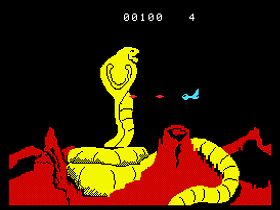 The Game: As superhero Adam Power, you’re the pilot of a space sled on patrol around the explosive Volcan Rock, and what better cover for the bad guys? An enormous laser-eyed space serpent is coiled around the mountain, and you have to take it down single-handedly. Once you’ve baked the snake, you land your sled on the surface and have a shootout with Gryptogg, Raygoth and Arkus. Once you’ve beaten them back, you can explore the underground caverns, collecting their instruments of evil and exchanging fire with them again. When you escape from their maze, you advance to the next level and begin the fight anew. (North American Philips / Probe 2000, 1983 – unreleased)
The Game: As superhero Adam Power, you’re the pilot of a space sled on patrol around the explosive Volcan Rock, and what better cover for the bad guys? An enormous laser-eyed space serpent is coiled around the mountain, and you have to take it down single-handedly. Once you’ve baked the snake, you land your sled on the surface and have a shootout with Gryptogg, Raygoth and Arkus. Once you’ve beaten them back, you can explore the underground caverns, collecting their instruments of evil and exchanging fire with them again. When you escape from their maze, you advance to the next level and begin the fight anew. (North American Philips / Probe 2000, 1983 – unreleased)
Memories: This Colecovision adaptation of the Odyssey2 game (now there’s a phrase you’re never going to see again), based on a less-than-blockbuster-successful series of comics and action figures, adds more depth to the game than the dear old Odyssey ever could’ve managed. But it’s hard to tell how much depth, as the game was never completed.
Planet Of The Apes
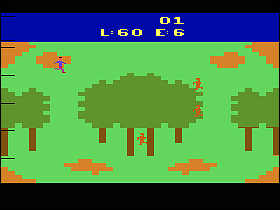 The Game: It’s not a good idea being a human on Earth of the future, in a world ruled ruthlessly by intelligent, verbose, violent apes. Or, in this case, persistent, pixellated apes. The player controls a hunted human trying to stay out of the apes’ damn dirty paws. If the human falls into the apes’ hands, an indelicate lobotomy is probably the best treatment he can expect. (20th Century Fox, 1983)
The Game: It’s not a good idea being a human on Earth of the future, in a world ruled ruthlessly by intelligent, verbose, violent apes. Or, in this case, persistent, pixellated apes. The player controls a hunted human trying to stay out of the apes’ damn dirty paws. If the human falls into the apes’ hands, an indelicate lobotomy is probably the best treatment he can expect. (20th Century Fox, 1983)
Memories: This is the story of a prototype that was rumored for many years, and with the popularity of the film and TV franchise, it was the subject of much speculation. Little did ardent collectors of unreleased VCS games know that the game was right under their noses the whole time… thanks to being mislabeled.
Pac-Man
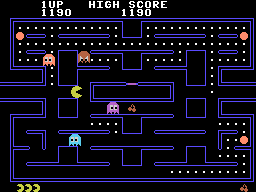 The Game: As a round yellow creature consisting of a mouth and nothing else, you maneuver around a relatively simple maze, gobbling small dots (10 points) and evading four colorful monsters who can eat you on contact. In four corners of the screen, large flashing dots (50 points) enable you to turn the tables and eat the monsters for a brief period for an escalating score (200, 400, 800 and 1600 points). Periodically, assorted items appear near the center of the maze, and you can consume these for additional points as well. The monsters, once eaten, return to their home base in ghost form and return to chase you anew. If cleared of dots, the maze refills and the game starts again, but just a little bit faster… (Atarisoft, circa 1983 [never released])
The Game: As a round yellow creature consisting of a mouth and nothing else, you maneuver around a relatively simple maze, gobbling small dots (10 points) and evading four colorful monsters who can eat you on contact. In four corners of the screen, large flashing dots (50 points) enable you to turn the tables and eat the monsters for a brief period for an escalating score (200, 400, 800 and 1600 points). Periodically, assorted items appear near the center of the maze, and you can consume these for additional points as well. The monsters, once eaten, return to their home base in ghost form and return to chase you anew. If cleared of dots, the maze refills and the game starts again, but just a little bit faster… (Atarisoft, circa 1983 [never released])
Memories: There are only so many ways you can really slice Pac-Man, but this unreleased ColecoVision edition – unearthed just in time for the 2001 Classic Gaming Expo – is one of the better ones.
Looping
 The Game: What if you were out to perform daring, air-show-style aerial acrobatics, and someone was shooting at you at the same time? Wouldn’t that be dandy? Lucky you, that’s what you’re doing in this game. With a mandate to DESTROY TERMINAL, you set out to obliterate an airport terminal protected by armed hot air balloons. The closer you get to carrying out that mission, the more fiercely they defend their turf. When you do level the terminal to the ground, a door opens up, allowing you to fly your plane into a massive maze of pipes, and if you can navigate that labyrinth, you reach “the end” – where you must fend off more adversaries to touch down safely and start again. (Coleco, 1983 – unreleased / recovered and released by CGE Services, 2003)
The Game: What if you were out to perform daring, air-show-style aerial acrobatics, and someone was shooting at you at the same time? Wouldn’t that be dandy? Lucky you, that’s what you’re doing in this game. With a mandate to DESTROY TERMINAL, you set out to obliterate an airport terminal protected by armed hot air balloons. The closer you get to carrying out that mission, the more fiercely they defend their turf. When you do level the terminal to the ground, a door opens up, allowing you to fly your plane into a massive maze of pipes, and if you can navigate that labyrinth, you reach “the end” – where you must fend off more adversaries to touch down safely and start again. (Coleco, 1983 – unreleased / recovered and released by CGE Services, 2003)
Memories: A positively obscure game in the arcades, Venture Line’s Looping really didn’t get any kind of a cult following until it was ported to the ColecoVision – and that translation was the best thing that ever happened to the game, gaining it a bit of popularity and an exclusive home.
Lasercade
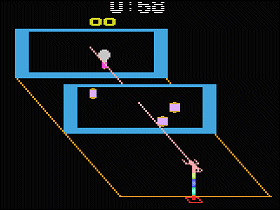 The Game: You’re manning an experimental laser in a shooting gallery, trying to zap objects as they cross a screen at the far end of the room. A direct hit scores points, but the clock is always ticking down and any objects that haven’t been shot down will remain in play until they’re eliminated. At the end of each round, you’ll be tasked with shooting the flame off of a candelabra, though its rapidly melting candles may make this trickier than you think. With each new level, targets get smaller – and rows of floating mirrors threaten to bounce your laser right back at you if you hit them instead of your target. (20th Century Fox, 1983 [never released])
The Game: You’re manning an experimental laser in a shooting gallery, trying to zap objects as they cross a screen at the far end of the room. A direct hit scores points, but the clock is always ticking down and any objects that haven’t been shot down will remain in play until they’re eliminated. At the end of each round, you’ll be tasked with shooting the flame off of a candelabra, though its rapidly melting candles may make this trickier than you think. With each new level, targets get smaller – and rows of floating mirrors threaten to bounce your laser right back at you if you hit them instead of your target. (20th Century Fox, 1983 [never released])
Memories: In video game terms, lasers are like the opposite of the weather – everyone fires them, but nobody ever talks about them. Though Lasercade belongs to the same category as Carnival and Shootin’ Gallery, its 3-D angle on the basic shooting gallery game is unique in the 2600 library, and for the first time, it really plays with the underlying concept and physical reality of firing lasers. Really.
Killer Bees
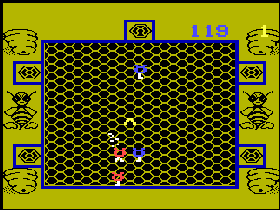 The Game: You control a solitary swarm of “good” bees, trailed by a couple of handy ray guns on the same vertical axis. The game starts out with a bunch of dim-witted Beebots bumbling around the screen, which you can sting with your bee swarm until the ‘bots slow down and finally expire, marked by a rather grim little tombstone! This probably sounds easy enough, but there are killer bees from outer space emerging from hives around the edge of the play area, and when their swarms collide with your swarm, you lose bees. The only defense against the killer bees is a pair of ray guns, which have to recharge after every use. (North American Philips, 1983)
The Game: You control a solitary swarm of “good” bees, trailed by a couple of handy ray guns on the same vertical axis. The game starts out with a bunch of dim-witted Beebots bumbling around the screen, which you can sting with your bee swarm until the ‘bots slow down and finally expire, marked by a rather grim little tombstone! This probably sounds easy enough, but there are killer bees from outer space emerging from hives around the edge of the play area, and when their swarms collide with your swarm, you lose bees. The only defense against the killer bees is a pair of ray guns, which have to recharge after every use. (North American Philips, 1983)
Memories: Another example of how Philips might have revised existing Odyssey2 games for their new platform, Killer Bees winds up being another example of how ungraceful the transition could’ve been.
Flash Point
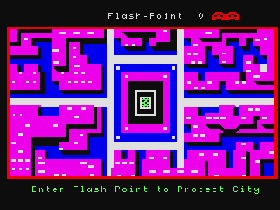 The Game: A zombie infestation has overrun the city. The player, in a mobile unit bristling with weapons, must venture into the infested areas and eliminate the zombies – or die. The center of the infestation screens features a green area surrounding the player’s vehicle; this must be preserved as much as possible while fighting off the zombies, as bonus points are awarded for guarding that space. If the player survives, it’s time to move on to the scene of the next zombie attack. (North American Philips, 1983 – unreleased prototype)
The Game: A zombie infestation has overrun the city. The player, in a mobile unit bristling with weapons, must venture into the infested areas and eliminate the zombies – or die. The center of the infestation screens features a green area surrounding the player’s vehicle; this must be preserved as much as possible while fighting off the zombies, as bonus points are awarded for guarding that space. If the player survives, it’s time to move on to the scene of the next zombie attack. (North American Philips, 1983 – unreleased prototype)
Memories: The only game custom-made specifically for the upgraded hardware of N.A.P.‘s never-released Odyssey3 console, Flash Point is a kind of action game that simply couldn’t have been executed with the same finesse on the Odyssey2.